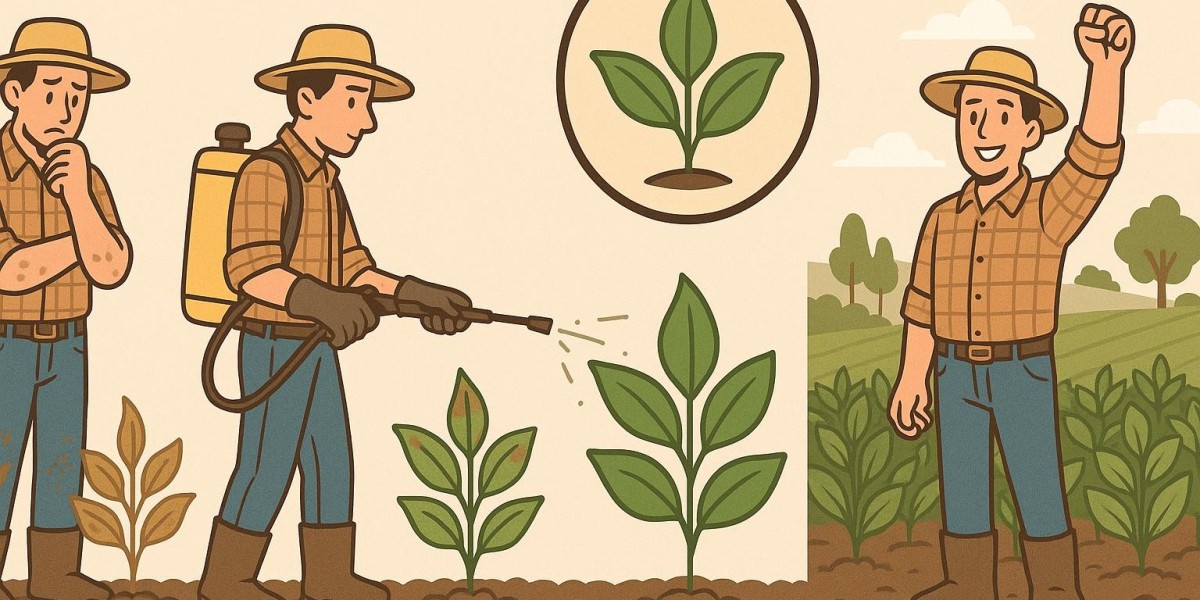Fungal diseases can silently weaken crops before symptoms appear. A reliable fungicide not only controls infection but also enhances overall plant performance. This article explores eight powerful ways a dual-mode fungicide—such as a Hexaconazole + Zineb combination—supports plant health and significantly increases yield.
Each benefit is tied to a biological process or agronomic result, showing how strategic fungicide use becomes an asset for productivity.
1. Targets Fungal Pathogens with Dual-Action Precision
Broader protection is provided by a fungicide that combines a systemic and a contact action. By preventing sterol production within plant tissues, hexaconazole inhibits fungal growth from within. Zineb stays on the surface and prevents spores from germinating.
This two-fold action:
- Reduces fungal colonization within the leaf
- Blocks reinfection from surrounding plant material
Controlling the leaf spot in groundnuts or sheath blight in rice requires this level of accuracy. The Indian Council of Agricultural Research's field data indicates that under these circumstances, control efficiency can reach 85%.
This dual-action approach protects both the leaf and root systems by establishing a zone of resistance in humid agro-ecological zones, where fungus spores proliferate rapidly.
2. Improves Photosynthetic Activity and Nutrient Uptake
Fungal stress reduces photosynthesis by damaging chloroplast-rich tissues. By eliminating infections early, fungicides restore the photosynthetic apparatus. Plants maintain higher chlorophyll levels, resulting in improved carbohydrate synthesis.
This recovery translates to:
- More leaf area index (LAI) over time
- Stronger root growth and micronutrient absorption
Research on chilli and soybeans indicates that treated crops had 18% more leaf greenness than untreated plots following the second spray. Better nutrient mobilisation from the root to the reproductive zones is made possible by healthier leaves, which directly contributes to increased output.
Growers seeking to gain these advantages in early crop stages often opt to purchase Avtar Fungicide, particularly where consistent disease pressure necessitates a single application that provides both preventive and curative responses. The active ingredients penetrate efficiently, enabling plants to recover more quickly from biotic stress.
3. Enhances Disease Resistance and Crop Uniformity
Consistent fungicide use across the growing cycle builds resilience. Crops treated preventively show delayed onset of secondary diseases, particularly in overlapping cropping zones. This makes fungicides valuable not only for disease management but also for uniform development.
Uniform crops offer:
- Simultaneous flowering and fruit setting
- Predictable harvest windows
Synchronous flowering is particularly advantageous to tomato and grape growers as it streamlines management and lowers expenses during picking and pruning. Regular application improves field cleanliness over time by reducing the spore load in soil and on crop residue.
4. Reduces Losses During Critical Growth Stages
Reproductive stages such as flowering and grain filling are vulnerable to pathogen attacks. If fungal diseases appear during these phases, the damage to yield is irreversible.
Hexaconazole + Zineb fungicides provide residual action lasting 10–12 days per spray, guarding these critical stages. According to the Plantwise Knowledge Bank, strategic spraying during pre-anthesis can improve pod setting by 22% in groundnut and seed filling by 19% in mustard.
This extended protection helps avoid yield dips and ensures better seed and fruit weight. It also reduces the need for repeat sprays, lowering cost and minimizing residue on harvested produce.
“A healthy plant protects its future yield not just by surviving, but by completing its cycle without interruption.”
5. Minimizes Environmental Stress Interactions
When plants are exposed to both disease and drought, stress intensifies. Effective fungicide coverage can reduce the internal stress load, allowing plants to conserve energy for water retention and nutrient cycling.
Fungicide-treated plants display:
- Higher proline accumulation (a stress marker)
- Lower transpiration rates under drought conditions
These metabolic processes support better adaptation during temperature changes and water shortages. Abiotic stress tolerance can be increased by up to 30% by lowering disease load early, according to research from the American Phytopathological Society.
Due to the connection between climate adaptability and disease control, fungicides play a crucial role in precision farming systems.
6. Supports Safe and Attractive Harvest Quality
Post-harvest diseases such as anthracnose or black mold reduce shelf life and market value. Applying fungicide during the late flowering or early fruiting stage builds a chemical shield that limits pathogen entry through minor injuries.
Especially in crops like banana, citrus, and mango, disease-free fruits show:
- Better skin integrity
- Lower microbial spoilage in transit
When appropriately used, residue-safe fungicides such as Hexaconazole + Zineb leave very little residue behind. Appropriate pre-harvest intervals guarantee adherence to both export and domestic regulations. This formulation is suitable for high-value horticulture, with a PHI of around 14 days.
7. Increases Yield Per Hectare with Measurable Gains
Yield improvement is the most tangible proof of fungicide efficiency. Comparative trials in chili fields showed that treated plots recorded:
- 26% higher fruit count
- 17% increase in fruit size
Early spraying resulted in a net gain of 390 to 530 kg per hectare in wheat and paddy trials conducted in five districts of Uttar Pradesh. Disease-free tissue results in stronger grains and more heads per plant when systemic action reaches the panicles and tillers.
Even small-scale farmers are encouraged to employ fungicides over the long term by this kind of financial gain, particularly when combined with weather-based alerts and intelligent application schedules.
8. Helps Optimize Input Use and Field Operations
Modern fungicides enhance operational efficiency. Farmers save time, fuel, and labour when fewer sprays are required. Sprayers with long residual activity require fewer visits to the field, freeing up labor for other important duties.
Farmers using Hexaconazole + Zineb reported:
- Up to 32% savings in spray fuel consumption
- 2.5 fewer field entries per crop season
This efficiency also lowers the risk of overexposure for applicators and reduces soil compaction from repeated machinery movement.
Tank-mix compatibility is another advantage. This fungicide can be combined with insecticides or micronutrients without compromising efficacy, streamlining operations and reducing per-application costs.
Frequently Asked Questions
- Can this fungicide be used in organic farming?
No, Hexaconazole and Zineb are synthetic fungicides and are not approved for use in organic systems. - What is the best time to apply the first spray?
Apply at the early vegetative stage or when disease signs are first visible. Preventive use offers the best results. - How long does the protection last after the spray is applied?
The residual effect lasts 10 to 12 days under average conditions. In high rainfall, this duration may be reduced. - Does it harm beneficial insects or pollinators?
If applied correctly and not during flowering, the risk to pollinators is minimal. Avoid spraying when bees are active. - How should it be stored?
Store in a cool, dry place away from food and feed. Keep containers tightly closed and labeled correctly.
What Else Should Growers Focus on Next?
One aspect of managing plant health is disease control. Combining fungicides with moisture sensors, AI-based pest alerts, and soil diagnostics will help maximise their use even more as farms become more data-driven.
Biologically improved carriers or smart-release systems might be part of future fungicide technology. These developments will maintain excellent performance while reducing the environmental impact. Farmers can already reap the benefits of scheduling pesticides per resistance rotation plans, crop cycles, and weather forecasts.
Combining digital platforms with chemical techniques to map disease occurrence, forecast outbreaks, and modify dosage is the next great step. Every fungicide drop will function more effectively, intelligently, and cleanly than ever before with the correct integration.



